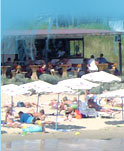
NESSEBAR
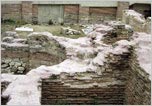 Nessebar - a small piece of land embraced by the sea, tied with a narrow rope-like neck to the quay of the continent. Nessebar - a small piece of land embraced by the sea, tied with a narrow rope-like neck to the quay of the continent.
The time and waves were merciful and have left us, the descendants, this marvelous creation of the nature, together with the ruins of the built by our ancestors architectural inheritance.The town is situated southwards of the last branches of the ancient Hemus Mountain (today's Stara Planina), which gradually lower to the Black Sea and at Cape Emine their rocks touch the water.
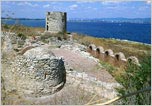 The old town is long only 850 m and is 350 m wide. During the different periods of its existence it has lost 1/3 of its territory, which sank into the sea. Under the water, 80 meters away from the coast still can be seen remains of the fortress's walls. The old town is long only 850 m and is 350 m wide. During the different periods of its existence it has lost 1/3 of its territory, which sank into the sea. Under the water, 80 meters away from the coast still can be seen remains of the fortress's walls.
At present is preserved only the western wall with the gate, which defended the town from the mainland. The Nesebur Peninsula - the ancient Mesambria, which was called Mesemvria in the Early Middle Ages and later - Nesebur, was populated more than three millenniums ago, at the end of the Bronze Age. The ancient Thracians named it Melsambria, what in their language means "the town of Melsa" - the legendary founder of the settlement. Melsambria has had two convenient harbours - a northern and a southern one, in which still are being found remains of the ancient ships' equipment.
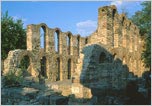 About the end of the 6th B.C. century, the first Greek colonizers arrived in the settlement - they were Dorians by origin. The settlement was gradually fortified; temples, gymnasium and theater were built. The settlement transformed itself in a classical polis - a town with the respective structure, functions and administration. About the end of the 6th B.C. century, the first Greek colonizers arrived in the settlement - they were Dorians by origin. The settlement was gradually fortified; temples, gymnasium and theater were built. The settlement transformed itself in a classical polis - a town with the respective structure, functions and administration.
In the town were built ships, a number of handicrafts was developed - mainly processing of metal. Mesambria began making own coins around 440 B.C.
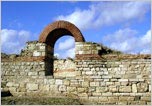 The town has reached its boom during the 3rd-2nd B.C. centuries when also gold coins were emitted. It maintained busy trade relations with the towns along the Black and Aegean Seas, as well as those on the Mediterranean coast. The numerous findings from that period, exhibited in the town's Archeological Museum, are material expression of the rich economic, cultural and spiritual life of the town. The town has reached its boom during the 3rd-2nd B.C. centuries when also gold coins were emitted. It maintained busy trade relations with the towns along the Black and Aegean Seas, as well as those on the Mediterranean coast. The numerous findings from that period, exhibited in the town's Archeological Museum, are material expression of the rich economic, cultural and spiritual life of the town.
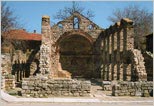 In the course of 62 years, from 1201 till 1263, the towns along the Black Sea coast, situated to the south of Balkan Mountain, including Nesebur, were lastingly included in the borders of the Bulgarian state. The town had a significant role in the political history of Bulgaria and Byzantium during the time when on the throne were sitting the Bulgarian Tsars Kaloyan, Ivan Asen II and Konstantin Tih. In the course of 62 years, from 1201 till 1263, the towns along the Black Sea coast, situated to the south of Balkan Mountain, including Nesebur, were lastingly included in the borders of the Bulgarian state. The town had a significant role in the political history of Bulgaria and Byzantium during the time when on the throne were sitting the Bulgarian Tsars Kaloyan, Ivan Asen II and Konstantin Tih. During this time were built the churches "Sveta Petka" (Paraskeva) - 13th century, "Sveti Todor" - 14th century, "Sveti Archangeli Mihail and Gavrail" (St. Archangels Mihail and Gavrail) - 14th century, which have direct analogues in the architecture of the capital Turnovo. Nesebur has maintained active trade relations with Constantinople, Venice, Genoa, Pisa, Ancona, Dubrovnik and other towns. After a period of about 40 years, during which Nesebur was ruled by Byzantium, it was again integrated with the Bulgarian state by Tsar Todor Svetoslav. During this time were built the churches "Sveta Petka" (Paraskeva) - 13th century, "Sveti Todor" - 14th century, "Sveti Archangeli Mihail and Gavrail" (St. Archangels Mihail and Gavrail) - 14th century, which have direct analogues in the architecture of the capital Turnovo. Nesebur has maintained active trade relations with Constantinople, Venice, Genoa, Pisa, Ancona, Dubrovnik and other towns. After a period of about 40 years, during which Nesebur was ruled by Byzantium, it was again integrated with the Bulgarian state by Tsar Todor Svetoslav.
POMORIE
 Anchialo was a center of a strategy in Odriskoto kingdom during I Century BC - I Century AD. The period of a great growth of Pomorie started when Thrace became a Roman province. In Paleocastro countryside (old fortress) one of the biggest by territory antic towns had been build, named Ulpyanon Anchyalenom. Main military and trade port on the West Black Seaside, Pomorie according to the words of Amyan Mercelin, is " A Great Town". Inspite of a large number of barbaric's attacks, the town managed to be on this first position until 740 AD when after a natural cataclysm it was destroyed and today its ruins are under the sea level. In its rebuilding, the town was set on the same terrain on which the old part of the town is. Anchialo was a center of a strategy in Odriskoto kingdom during I Century BC - I Century AD. The period of a great growth of Pomorie started when Thrace became a Roman province. In Paleocastro countryside (old fortress) one of the biggest by territory antic towns had been build, named Ulpyanon Anchyalenom. Main military and trade port on the West Black Seaside, Pomorie according to the words of Amyan Mercelin, is " A Great Town". Inspite of a large number of barbaric's attacks, the town managed to be on this first position until 740 AD when after a natural cataclysm it was destroyed and today its ruins are under the sea level. In its rebuilding, the town was set on the same terrain on which the old part of the town is.
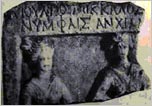 During the Whole Middle Ages Pomorie saved its condition as a main transport, trade and military center of Prichernomorska Trakya. This is the reason the town was "an apple of discord" as well between Bulgaria and Byzantine Empire. As a result of a number military operation by land and by sea, the most famous of which was the battle near the Acheloy river in August, 917,when the Army of the Byzantines was destroyed by the Army of Simeon Veliki, the town was at times in Bulgarian boundary, at times in Byzantine boundary. Anchialo is one of the last towns, captured by the Turkish. Producing and trade with grain, wine, fish, wood and other agricultural products, which are of important significance for the town prosperity was gradually displaced by unknown until X Century AD means of livelihood - salt-producing. During the Whole Middle Ages Pomorie saved its condition as a main transport, trade and military center of Prichernomorska Trakya. This is the reason the town was "an apple of discord" as well between Bulgaria and Byzantine Empire. As a result of a number military operation by land and by sea, the most famous of which was the battle near the Acheloy river in August, 917,when the Army of the Byzantines was destroyed by the Army of Simeon Veliki, the town was at times in Bulgarian boundary, at times in Byzantine boundary. Anchialo is one of the last towns, captured by the Turkish. Producing and trade with grain, wine, fish, wood and other agricultural products, which are of important significance for the town prosperity was gradually displaced by unknown until X Century AD means of livelihood - salt-producing.
During XV-XIX Century Anchialo is one of the two biggest salt-producing centers in the Ottoman Empire ( Solon is the other). Inspite of the general decline of sea towns during Turkish slavery, Anchialo had still been a main town of Prichernomorska Trakya when the Liberation came. A number of objective and subjective conditions caused its decay. The most important of which were: building of a modern port in neighbour Bourgas as well as burning down Pomorie. Anchialo was in ruins on July 30, 1906
|
 |
